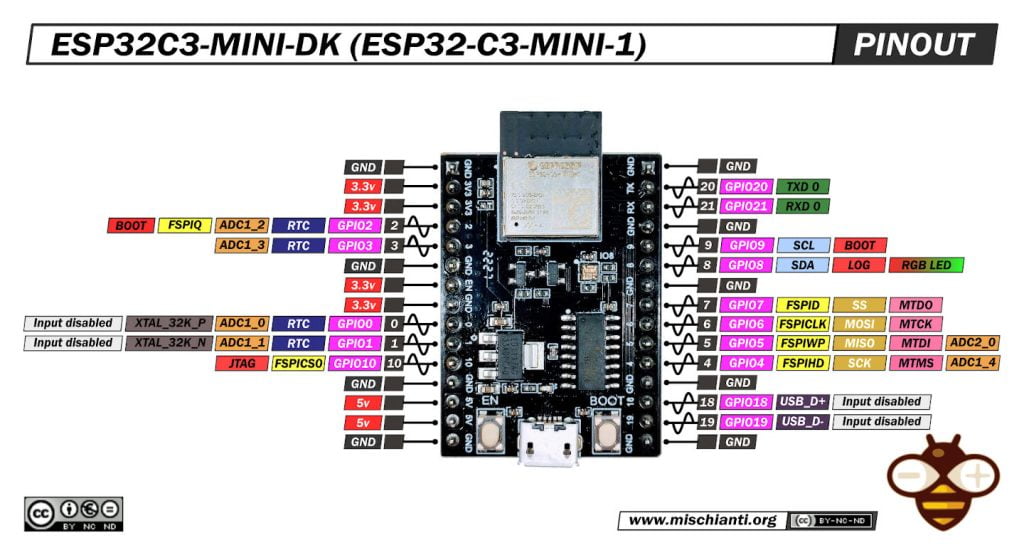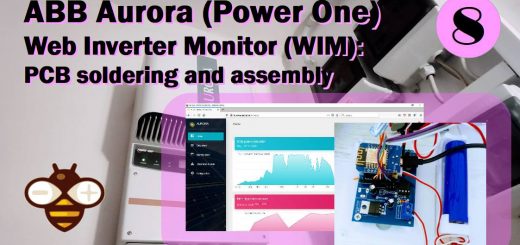ESP32C3-MINI-DK: high-resolution pinout and specs
The ESP32-C3-MINI-DK is a clone of ESP32-C3-DevKitM-1, and like the original It’s a compact, feature-rich development board for IoT applications and embedded systems development. It is built around the ESP32-C3-MINI-1 microcontroller, which is a single-core, 32-bit RISC-V processor with integrated 2.4 GHz Wi-Fi and Bluetooth 5.0 LE (Low Energy) connectivity.
| Main Components | introduce |
| ESP32C3-MINI-1 Mods | ESP32C3-MINI-1 is a universal Wi-Fi and low-power Bluetooth dual module launched by Espressif, with powerful functions. The module adopts PCB onboard antenna and is equipped with 4MB SPI flash |
| Pin headers | All available GPIO pins have been drawn out to the development board headers |
| 5V to 3V3 LDO | Power converter, input 5V, turn out 3.3V |
| Micro USB Port | USB interface, can be used as the power supply interface of the development board, can burn firmware to the chip, and can communicate with the chip through the USB protocol |
| USB-To-UART Converter Chip | Single-chip USB to UART bridge for increased transfer rates up to 3Mbps |
| RGB LED | Addressable RGB LEDs driven by GPIO8 |
PINs
UART (Universal Asynchronous Receiver-Transmitter) pins:
- U0RXD (GPIO20): This pin serves as the UART0 receive (RX) pin, which is used for receiving serial data.
- U0TXD (GPIO21): This pin serves as the UART0 transmit (TX) pin, which is used for transmitting serial data.
I2C (Inter-Integrated Circuit) pins: The ESP32-C3 does not have dedicated I2C pins. However, you can implement software-based I2C (bit-banging) using any available GPIO pins. For instance, you could use GPIO12 (SPIHD) and GPIO13 (SPIWP) for the I2C SCL (clock) and SDA (data) pins, respectively.
The BOOT (IO09) pin cannot be pulled down before power-on, and the ESP32 will enter the download mode.
Specs
CPU and OnChip Memory
- ESP32-C3FH4 or ESP32-C3FN4 embedded, 32-bit RISC-V single-core processor, up to 160MHz
- 384 KB ROM
- 400 KB SRAM (16 KB for cache)
- 8 KB SRAM in RTC
- 4 MB flash in chip package
ESP32-C3-MINI-1 (ANT) Series Comparison
| Ordering Code | Flash | Ambient Temp. (°C) | Size (mm) |
|---|---|---|---|
| ESP32-C3-MINI-1-N4 | 4 MB (Quad SPI) | –40 ∼ 85 | 13.2 × 16.6 × 2.4 |
| ESP32-C3-MINI-1-H4 | 4 MB (Quad SPI) | –40 ∼ 105 | |
| ESP32-C3-MINI-1-H4-AZ | 4 MB (Quad SPI) | –40 ∼ 105 |
ESP32-C3-MINI-1U (CONN) Series Comparison
| Ordering Code | Flash | Ambient Temp. (°C) | Size (mm) |
|---|---|---|---|
| ESP32-C3-MINI-1U-N4 | 4 MB (Quad SPI) | –40 ∼ 85 | 13.2 × 12.5 × 2.4 |
| ESP32-C3-MINI-1U-H4 | 4 MB (Quad SPI) | –40 ∼ 105 |
WiFi
- IEEE 802.11 b/g/n-compliant
- Center frequency range of operating channel: 2412 ~ 2484 MHz
- Supports 20 MHz, 40 MHz bandwidth in 2.4 GHz band
- 1T1R mode with data rate up to 150 Mbps
- Wi-Fi Multimedia (WMM)
- TX/RX A-MPDU, TX/RX A-MSDU
- Immediate Block ACK
- Fragmentation and defragmentation
- Transmit opportunity (TXOP)
- Automatic Beacon monitoring (hardware TSF)
- 4 × virtual Wi-Fi interfaces
- Simultaneous support for Infrastructure BSS in Station mode, SoftAP mode, Station + SoftAP mode, and promiscuous mode Note that when ESP32-C3 series scans in Station mode, the SoftAP channel will change along with the Station channel 802.11mc FTM
Bluetooth
- Bluetooth LE: Bluetooth 5, Bluetooth mesh
- Speed: 125 Kbps, 500 Kbps, 1 Mbps, 2 Mbps
- Advertising extensions
- Multiple advertisement sets
- Channel selection algorithm #2
- Internal co-existence mechanism between Wi-Fi and Bluetooth to share the same antenna Peripherals
Peripherals
- GPIO, SPI, UART, I2C, I2S, remote control peripheral, LED PWM controller, general DMA controller, TWAI® controller (compatible with ISO 11898-1, i.e. CAN Specification 2.0), USB Serial/JTAG controller, temperature sensor, SAR ADC, general-purpose timers, watchdog timers
Integrated Components on Module
- 40 MHz crystal oscillator
Antenna Options
- On-board PCB antenna (ESP32-C3-MINI-1)
How to
- ESP32: pinout, specs and Arduino IDE configuration
- ESP32: integrated SPIFFS Filesystem
- ESP32: manage multiple Serial and logging
- ESP32 practical power saving
- ESP32 practical power saving: manage WiFi and CPU
- ESP32 practical power saving: modem and light sleep
- ESP32 practical power saving: deep sleep and hibernation
- ESP32 practical power saving: preserve data, timer and touch wake up
- ESP32 practical power saving: external and ULP wake up
- ESP32 practical power saving: UART and GPIO wake up
- ESP32: integrated LittleFS FileSystem
- ESP32: integrated FFat (Fat/exFAT) FileSystem
- ESP32-wroom-32
- ESP32-CAM
- ESP32: use ethernet w5500 with plain (HTTP) and SSL (HTTPS)
- ESP32: use ethernet enc28j60 with plain (HTTP) and SSL (HTTPS)
- How to use SD card with esp32
- esp32 and esp8266: FAT filesystem on external SPI flash memory
- Firmware and OTA update management
- Firmware management
- OTA update with Arduino IDE
- OTA update with Web Browser
- Self OTA uptate from HTTP server
- Non-standard Firmware update
- Integrating LAN8720 with ESP32 for Ethernet Connectivity with plain (HTTP) and SSL (HTTPS)
- Connecting the EByte E70 to ESP32 c3/s3 devices and a simple sketch example
- ESP32-C3: pinout, specs and Arduino IDE configuration
- Integrating W5500 with ESP32 Using Core 3: Native Ethernet Protocol Support with SSL and Other Features
- Integrating LAN8720 with ESP32 Using Core 3: Native Ethernet Protocol Support with SSL and Other Features
- Dallas ds18b20:
- Guide to I2C on ESP32: Communication with Heterogeneous 5V and 3.3V Devices, Additional Interface Management and Scanner
- Display
- Complete Guide: Using an ILI9341 Display with the TFT_eSPI Library
- Integrating Touch Screen Functionality with Your ILI9341 TFT Display
- SSD1683 eInk Display with GxEPD and ESP32 (and CrowPanel 4.2″ HMI): basics and configuration
- SSD1683 eInk Display with GxEPD and ESP32 (and CrowPanel 4.2″ HMI): fonts, shapes, and images
- ESP32 e Display eInk SSD1683: come realizzare una Semplice Stazione Meteo (anche su CrowPanel 4.2″ HMI) con le API di OpenWeatherMap
- ESP32 and ESP8266: Sending Emails with Attachments (EMailSender v4.0.0 Library) with complete STARTTLS Support
Datasheet
ESP32-C3-MINI-1 Datasheet datasheet
ESP32-C3-DevKitM-1 Schematic
ESP32-C3-DevKitM-1 PCB Layout
Thanks
- Arduino
- esp8285
- esp8266
- ESP32
- DOIT ESP32 DEV KIT v1
- ESP32 DevKitC v4
- ESP32 WeMos LOLIN32
- ESP32 WeMos LOLIN32 Lite
- ESP32 WeMos LOLIN D32
- ESP32-wroom-32
- NodeMCU-32S
- ESP32-S
- ESP32-CAM
- ESP32-2432S028 (Cheap Yellow Display)
- ESP32-2432S032 (Cheap Yellow Display)
- ESP32 s2
- ESP32c3
- ESP32s3
- Arduino SAMD
- STM32
- Raspberry Pi
- Arduino
- esp8285
- esp8266
- ESP32
- DOIT ESP32 DEV KIT v1
- ESP32 DevKitC v4
- ESP32 WeMos LOLIN32
- ESP32 WeMos LOLIN32 Lite
- ESP32 WeMos LOLIN D32
- ESP32-wroom-32
- NodeMCU-32S
- ESP32-S
- ESP32-CAM
- ESP32-2432S028 (Cheap Yellow Display)
- ESP32-2432S032 (Cheap Yellow Display)
- ESP32 s2
- ESP32c3
- ESP32s3
- Arduino SAMD
- STM32
- Raspberry Pi












